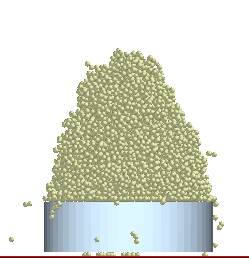Dear lammps developers.
I am using lammps to make particle discrete elements and the purpose I want to achieve is the agglomeration of granular powders and the breaking up of agglomerates using ultrasonic waves.
In lammps I placed a cylinder at the bottom and the particles fell from above, but I found that the particles did not pile up on the cylinder as expected, but went straight through it.
(particle-particle and particle-wall contact modell are both jkr modell)
Following your last reply I have reduced the gravity and reduced the velocity of the particles and adjusted the time step to the minimum Rayleigh time step.
For lammps I think I must have missed some important steps and still haven’t found a relevant solution. If you have time,could you give me some valuable advice
sincerely,
cute
code is attached below
variable name string pour_into_box
atom_style sphere
units si
###############################################
Geometry-related parameters
###############################################
variable boxx equal 1000e-6
variable boxy equal 1000e-6
variable boxz equal 1300e-6
###############################################
Particle-related parameters
###############################################
variable rlo equal 7e-6
variable rhi equal 9e-6
variable dlo equal 2.0*{rlo}
variable dhi equal 2.0*{rhi}
variable dens equal 944.3038
variable skin equal 0.3*${rhi}
region boxreg block 0 {boxx} 0 {boxy} 0 ${boxz}
create_box 1 boxreg
change_box all boundary p p f
################################
#particle contact modell
################################
pair_style granular
pair_coeff 1 1 jkr 2.5e7 0.35 0.25 0.003 tangential mindlin 8e6 1.0 0.695 rolling sds 200 100 0.13 twisting marshall
comm_modify vel yes
region insreg1 cylinder z 500e-6 500e-6 100e-6 400e-6 900e-6
region cyl cylinder z 500e-6 500e-6 250e-6 0 50e-6 side out
fix 1 all nve/sphere
fix grav all gravity 1.0 vector 0 0 -1
fix ins1 all pour 8000 1 2555 region insreg1 vel 0 0 0 0 -0.0001 diam range {dlo} {dhi} dens {dens} {dens}
neighbor ${skin} bin
neigh_modify delay 0 every 1 check yes
#################################
#particle- wall contact modell
#################################
fix 2 all wall/gran/region granular jkr 1.8e11 0.35 0.3 0.0395 tangential mindlin 2000 1.0 0.6 rolling sds 500.0 200.0 0.405 twisting marshall region cyl
thermo_style custom step atoms ke
thermo_modify lost warn
thermo 100
compute 1 all ke
compute 2 all erotate/sphere
timestep 5.82e-8
dump 1 all custom 100 ${name}.dump id type radius mass x y z
run 3000000

